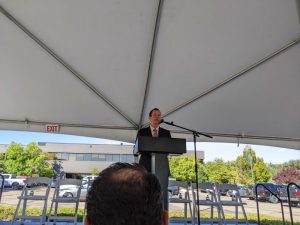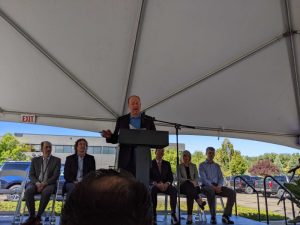By Kenna Hughes-Castleberry posted 28 Sep 2022
Colorado is quickly becoming the next hub for quantum computing. With organizations like NIST and JILA as well as companies like Maybell Quantum and Quantinuum positioned in the Denver area, the region boasts of one of the highest densities of quantum computing groups in the U.S. This year’s IEEE conference added even more awareness to Colorado’s growing quantum hub, as quantum companies from all over the world came to the state to network and learn. Now, Atom Computing, a market leader in neutral atom computing, is putting down roots in this innovative area by opening a new R&D facility in the heart of Boulder, Colorado.

Atom Computing’s CEO Rob Hays discusses the opening of the new R&D facility in Boulder Colorado (PC Kenna Hughes-Castleberry)
This new facility not only offers state-of-the-art laboratories for the company’s many engineers to work on this technology, but the building and the surrounding area offer flexibility for the future goal of scaling up the quantum system. According to Atom Computing’s CEO Rob Hays, the Boulder facility is designed to hold many generations of quantum computing. Hays added that the plan is to offer commercial quantum systems out of the Boulder branch, along with cloud services. “Colorado has a growing ecosystem of different components, from the hardware vendors to the research to the workforce,” explained Justin Ging, Chief Product Officer of Atom Computing. “It all comes together. And we see this as where we want to build out our commercial activity. So, we’ve got a large space with room to grow.”

Colorado Governor Jared Polis speaks at the grand opening of Atom Computing’s new R&D facility (PC Kenna Hughes-Castleberry)
Atom Computing officially opened the branch with a ceremony attended by key figures from industry, research, and even federal and local governments. Colorado Governor Jared Polis spoke on how the new branch reflects the great quantum ecosystem within the state. “This is the next exponential improvement in computing,” Polis stated, adding that “you can’t have a better place.” Along with its new facility, the company will also pledge $100 million to Colorado over the next three years. This investment would add more jobs and money to the state’s economy, Polis explained.
Atom Computing already has deep ties to Colorado’s quantum institutions as co-founder and Chief Technology Officer Ben Bloom began the company after graduating from JILA, a partnership between NIST and the University of Colorado Boulder. Bloom studied under JILA and NIST Fellow Jun Ye (who is now the company’s scientific advisor) and helped develop the current generation of atomic clocks. Since then, Atom Computing has become a popular company for CU Boulder graduates. Because of Bloom’s connections to NIST and the University, the company has collaborated and will continue to collaborate with both. As Missy Diehl, the Director of Industry Relations for the CUbit Quantum Initiative, a CU Boulder quantum network, stated: “We’re excited to see Atom Computing build the next generation of quantum computers in Colorado.” NIST echoed these sentiments, as Andrew Wilson, the Chief of NIST’s Quantum Physics Division, added: “We look forward to opportunities to collaborate with Atom Computing on future projects.”
While Atom Computing is the newest quantum company setting up shop in Colorado, they certainly will not be the last, as the state’s ecosystem continues to grow. “We’re generally very excited about the community here,” Bloom added. “It’s a really vibrant group and we’re glad to be a part of it.”













